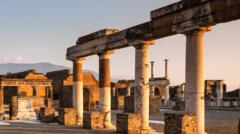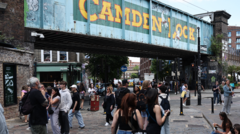Could Pompeii's Ruins Be Home Again? Archaeologists Weigh In!

Revisiting the Ashes: Life Among the Ruins of Pompeii After the Eruption
The history of Pompeii is a tale of tragedy and resilience. A thriving Roman city, Pompeii was tragically buried under volcanic ash when Mount Vesuvius erupted in AD 79, claiming thousands of lives and preserving the city in time. New evidence has surfaced indicating that some survivors returned to the ruins, seeking refuge and resources among the remnants of their former lives. This article delves into these recent findings, exploring what life was like in post-eruption Pompeii, the archaeological implications, and the significance of this new understanding of human tenacity.
The Eruption of Mount Vesuvius: A Brief Overview
Before diving into the post-eruption life, it's essential to understand the catastrophic event itself. In AD 79, the eruption of Mount Vesuvius unleashed a torrent of molten rock, pumice, and hot ash, burying the city of Pompeii and nearby Herculaneum. The suddenness of the eruption caught the residents off guard, leading to a swift and devastating loss of life. The ash and debris that enveloped the city preserved many aspects of Roman life, creating a unique archaeological site that provides insights into this ancient civilization.
The Return to Ruins: Evidence of Resettlement
Recent archaeological studies have brought to light compelling evidence that some survivors returned to Pompeii after the eruption. These findings suggest that not all who lived in the city sought to escape its shadow permanently. Instead, many were drawn back, either due to financial constraints or the desire to reclaim what had been lost.
Life Without Infrastructure
Archaeologists have discovered that the individuals who returned did not find a city bustling with the rich infrastructure typical of Roman life. Instead, they encountered a landscape of ruins. The settlements that emerged were informal and characterized by a lack of basic services, such as sanitation and reliable shelter. This new societal structure resembled a makeshift camp or favela, rather than a thriving city.
The Archaeological Findings
Recent excavations have revealed significant insights into how these returnees adapted to their new reality. Evidence indicates that people may have lived in the upper floors of homes, which remained intact above the layers of ash, while converting lower floors into cellars. This adaptation allowed them to utilize the remnants of their former city while scavenging for valuable objects that had survived the eruption.
The Role of Valuables in Post-Eruption Life
Surviving in a devastated city required ingenuity and resourcefulness. The ruins of Pompeii offered opportunities for individuals to search for valuable artifacts that could be repurposed or sold. This scavenging not only provided essential resources but also connected the survivors to their past, as they sought to reclaim their former lives amidst the rubble.
The Historical Context of Resettlement
Historically, the idea that survivors returned to Pompeii has been a subject of speculation. However, recent research confirms that this phenomenon continued for several centuries, with evidence suggesting ongoing habitation until the 5th century. This provides a richer narrative of resilience and adaptation, showing that the human spirit can persist even in the face of overwhelming loss.
The Archaeological Significance of Post-Eruption Pompeii
The findings regarding the resettlement of Pompeii are not just significant for understanding the lives of those who returned; they also have broader implications for archaeological practices. Archaeologists have noted that the rush to uncover the artifacts preserved in the ash has often resulted in the loss of context for these resettlement traces. The site's director, Gabriel Zuchtriegel, emphasized that the narrative of destruction has overshadowed the story of recovery.
Preservation and Documentation Challenges
One of the critical challenges faced by archaeologists working in Pompeii is the preservation of evidence from the post-eruption period. As excavations continue, the faint traces of the site’s reoccupation have often been removed without proper documentation. This raises critical questions about how we interpret archaeological finds and the importance of contextualizing them within the broader historical narrative.
Lessons Learned from Pompeii's Resettlement
The story of Pompeii's survivors offers valuable insights into human resilience and adaptability. It serves as a reminder that, even in the direst circumstances, people find ways to rebuild and reclaim their lives. The return to the ruins reflects not only a struggle for survival but also a profound connection to one’s heritage and past.
Modern-Day Pompeii: A World-Famous Tourist Attraction
Today, Pompeii stands as one of the most significant archaeological sites globally, attracting millions of tourists each year. The preserved ruins offer a unique window into Roman life, allowing visitors to walk through streets that have remained largely unchanged for nearly two millennia. The juxtaposition of the ancient and the modern emphasizes the enduring impact of this historical site.
Tourism and Education at Pompeii
As a UNESCO World Heritage site, Pompeii plays a crucial role in education and cultural preservation. The site provides an unparalleled opportunity for visitors to learn about Roman architecture, daily life, and the catastrophic events that changed the course of history. Educational programs and guided tours focus on both the grandeur of the city before the eruption and the stories of those who returned to the ruins.
Conservation Efforts
Efforts to conserve Pompeii are ongoing, as the site faces challenges from weathering, human activity, and the sheer volume of visitors. Archaeologists and conservators strive to balance the need for preservation with the public's desire to explore this historical treasure. New technologies and methodologies are being employed to enhance conservation efforts while ensuring that the site remains accessible for future generations.
Conclusion: The Enduring Legacy of Pompeii
The story of Pompeii extends far beyond its initial destruction. The recent evidence of survivors returning to the ruins sheds light on the resilience of the human spirit and the lengths people will go to reclaim their lives. As we continue to uncover the layers of history buried beneath the ash, we gain a deeper understanding of the complex narratives that define our past.
What does the resilience of the Pompeii survivors teach us about overcoming adversity in our own lives? How can we apply these lessons to our modern challenges? Explore the layers of history that shape our understanding of human experience and survival, and consider how the stories of the past continue to resonate today. #Pompeii #Archaeology #Resilience
FAQs
What caused the eruption of Mount Vesuvius?
The eruption of Mount Vesuvius in AD 79 was caused by a build-up of pressure from magma within the volcano, leading to explosive volcanic activity that buried Pompeii and Herculaneum under ash and pumice.
How did people survive in post-eruption Pompeii?
Survivors adapted by living in the upper floors of buildings above the ash, scavenging for valuable objects, and forming informal settlements, often lacking basic infrastructure and services.
What is the significance of Pompeii today?
Pompeii is a UNESCO World Heritage site and a vital archaeological location that offers insights into Roman life, architecture, and the effects of natural disasters on human civilization.
How are modern conservation efforts preserving Pompeii?
Modern conservation efforts involve the use of new technologies and methodologies to protect the ruins from weathering and human activity while ensuring accessibility for tourists and researchers.
Published: 2025-08-06 22:56:13 | Category: technology



